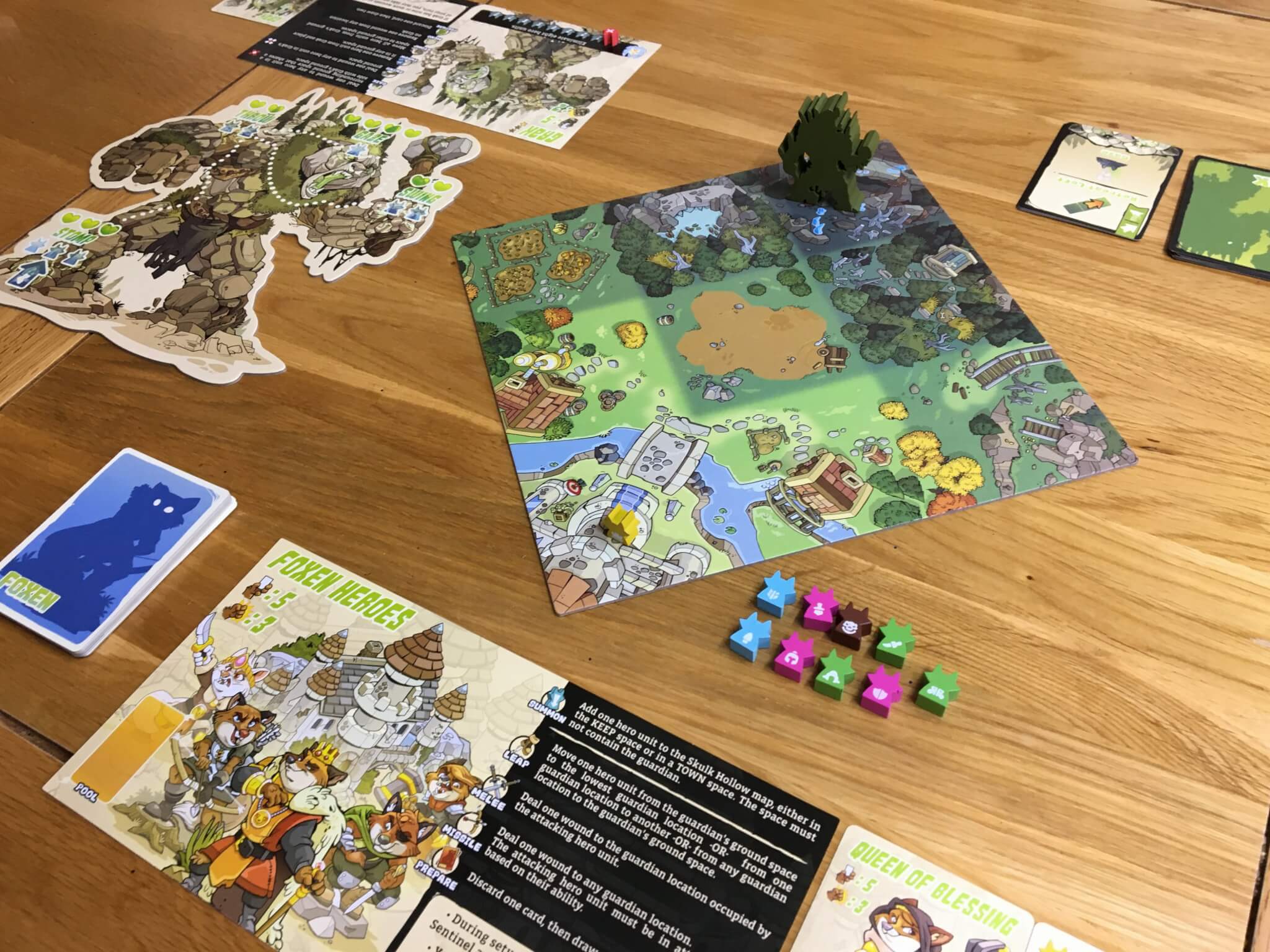The relationship between board games and video games is a strange one. Obviously board games came first, and have inspired many a digital conversion — yet sometimes, the opposite is true. Taking the immediacy of video games and translating them into an often turn-based and much less expansive medium can be tricky, yet still, some board games aim to do so. Skulk Hollow, from Pencil First Games, is clearly influenced by Ico and Shadow of the Colossus, yet it wisely steers clear of both an official license and the more whimsical elements of gameplay.
Skulk Hollow is a strictly two player game in which one player controls a team of “Foxen Heroes” whilst the other controls a single, massive Guardian. There are four Guardian’s in the base game, each with their own player mat, Guardian Board and nicely presented box of specific components, including cards, meeples and other paraphernalia. The Foxen Heroes also have a similar box of tricks, which will be used in every game.

When I make reference to Skulk Hollow’s similarities with Ico and Shadow of the Colossus, what I really mean is that the Foxen Heroes will need to climb up the guardian over the course of the game, damaging sections of it before it can complete whatever its ultimate objective is. This gives Skulk Hollow a hugely asymmetrical feeling. The Foxen Heroes will be lead by one of four monarchs, but will always be trying to achieve the same goal, but each Guardian has a very different intent.
Grak is perhaps the most straightforward Guardian to play as, with his aim simply being to defeat eight of the Foxen Heroes. Tanthos, on the other hand, will be aiming to get his six tentacles (beautifully represented as wooden meeples) onto the board. Clearly, the Guardians are much more powerful than the Foxen Heroes one-on-one, which is where things begin to get quite interesting.

The Foxen Heroes are represented by up to ten wooden meeples, each of which has a specific colour and icon. These meeples will be introduced to the board as the Foxen Heroes player plays cards that show those symbols. For example, if an Archer card is played with a small arrowhead symbol, then that meeple will be added to the board and the card (showing relevant stats and abilities) will be placed face up on the table beside the Foxen Heroes leader.
On their turn, both players will be playing cards from their hand that allow them to move, attack and take other actions. In the case of the Foxen Heroes, this includes things like being able to use the monarch ability, or the ability to spawn a new character as I mentioned above. For the Guardian player, cards allow the Guardian to move, and to use the abilities shown on their player mat — as long as they have not been disabled.

For the Foxen Heroes, disabling the Guardian is important for success, especially against an enemy like Tanthos who uses a specific ability to send out his tentacles. The Foxen Heroes can (usually) leap onto Guardians and will then climb up them, attacking specific weak points like legs, arms and so on, weakening and eventually disabling the abilities associated with those points. Guardians can almost always recover some of these hit points, but in doing so they must slow down and halt their broader plan.
In general terms, Skulk Hollow plays out with the Guardian initially advancing rapidly, whilst the Foxen Heroes player works tirelessly to amass an army that is large enough to begin dealing real damage. In the meantime, the Foxen Heroes will usually need to make sacrifices and find other ways to delay the progress of the Guardian. This can feel very different from one Guardian to the next.

To use the same two examples, Tanthos will want to be left alone during the early game, but Grak will come directly for the Foxen Heroes to squash out resistance as and when it appears, making sure that the Foxen Heroes never build up their power base. The other two Guardians (Apoda and Raptra) are also very different, and each of the Foxen Heroes monarchs also brings their own unique features. This potential for variation on both sides of the fight means up to sixteen different experiences as a minimum, and Skulk Hollow feels ripe for expansion to me.
A special mention for the components has to be given, since Skulk Hollow is gorgeous in every way. The artwork is fantastic, with hugely evocative monsters and heroes that look determined, resolute and, well, heroic. The hardware that represents them — from the large Guardian boards to the tiny health tokens — is all fantastic quality. Whilst it’s a small, niche game that only accommodates two players, it has AAA production that could be the centrepiece of any collection.

As long as you have space in your collection for a two player specific game (and let’s face it, some people only play at this count) then you need Skulk Hollow. Yes, it’s a head to head game with a thematic element, but it also has smart hand aspects of hand management, lots of strategic elements and also most no luck – there’s no dice rolling our random draws (aside from cards, which can be mitigated through various abilities.) Add these factors to the superb production quality, and Skulk Hollow is a definite winner.
You can purchase Skulk Hollow from Pencil First Games’ website.
Love board games? Check out our list of the top board games we’ve reviewed.
